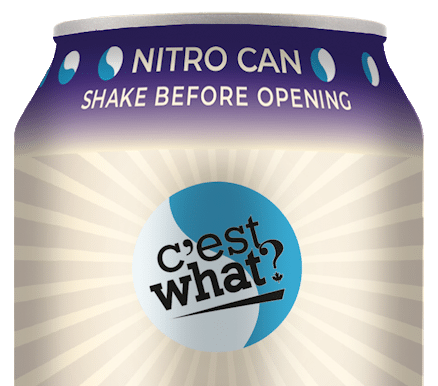 What is Nitro Beer?
What is Nitro Beer?
Most beer is carbonated through CO2, both naturally through fermentation and additionally through forced carbonation. To achieve peak effervescence, carbon dioxide is injected into the beer, pressurizing bottles, cans, or kegs. Nitro beer differs in that it contains a mixture of nitrogen and carbon dioxide, where nitrogen accounts for 70-75% of the mix, and carbon dioxide the remaining 25-30%.
Nitrogenated beer was originally developed to replicate traditional cask ale, which is naturally carbonated through fermentation, and naturally nitrogenated from the exposure to air when a pint is drawn from the cask.
History of Nitro Beer
In the 1950s, Michael Ash, a mathematician and brewer, was hired by Guinness to develop a nitrogen-infused beer. Ash was particularly interested in nitrogen because of its innocuous qualities, that it is a tasteless, odorless, and inert gas.
Ash found that nitrogen-infused beer had significantly lower carbon dioxide levels, allowing the beer to retain much of its natural taste, sweetness, and flavor, while minimizing the formation of carbonic acid. In 1959, Ash developed a system to brew Guinness using nitrogen to achieve its signature creamy taste and consistent quality.
Nitro Cascade
Due to nitrogen’s poor solubility, a nitro-infused keg needs to be pressurized and kept cold for it to dissolve in the beer. A tapered draught tap with restrictor plate forces beer through several tiny holes, allowing nitrogen to release quickly when a beer is poured. As depressurization occurs, the dissolved nitrogen begins its ascent, temporarily displacing beer by pushing it up and to the side. The cascade effect is created as beer falls back down along the side of the glass, pulling some of the smaller nitrogen bubbles down with it. After nitrogen escapes from the beer, it settles on top to form a smooth, velvety long-lasting head.
What is a Widget?
In 1988, brewers at Guinness developed a widget, or nitrogen-infused capsule, placed in bottles and cans to recreate the draught nitro beer experience. By dosing the beer with liquid nitrogen during packaging, the nitrogen rushes to the widget, which is kept in place under pressure. Opening a beer releases the pressure, allowing nitrogen to escape from the widget. Pouring aggressively into a glass at a 180-degree angle, encourages nitrogen to make its escape, activating the flowing sandbar effect as it releases out of the beer.
Nitro Beer Today
Over the years, liquid nitrogen dosing has improved to the point that the widget isn’t a necessary addition for canned and bottled beer. Nitrogenating beer works well for many beer styles, but is not particularly compatible with those that prioritize clean, tart or bitter flavours. A bitter West Coast IPA is by no means an ideal nitro brew, but a nitro-infused milkshake IPA can be pretty great. Advancements in brewing technology and nitro infusion has led to a greater ability to experiment across a more diverse spectrum of beer styles, with many surprising and unique results.
(Leah is a Toronto based freelance writer as well as the Beer Boss and a server at C’est What)


